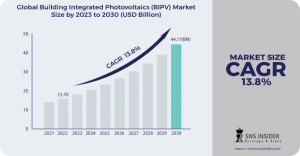Building Integrated Photovoltaics (BIPV) Market Will Reach at CAGR of 13.8% by 2030
Transforming Architecture: The Rising Potential of the Building Integrated Photovoltaics (BIPV) Market
TEXES, AUSTIN, UNITED STATES, June 3, 2024 /EINPresswire.com/ -- The Building Integrated Photovoltaics (BIPV) Market Size was valued at USD 15.70 billion in 2022 and is expected to reach USD 44.17 billion by 2030 with a growing CAGR of 13.8% over the forecast period 2023-2030.In the quest for sustainable and energy-efficient solutions, the Building Integrated Photovoltaics (BIPV) market has emerged as a groundbreaking segment within the renewable energy sector. BIPV technology seamlessly integrates solar panels into building structures, serving as both a functional construction material and a source of clean energy. As the global focus shifts towards green buildings and sustainable urban development, the BIPV market is poised for significant growth and innovation, revolutionizing the way we approach building design and energy consumption.
Download Sample Copy of Report: https://www.snsinsider.com/sample-request/2229
Top Key Players:
SolarWindow
Hanergy Mobile Energy Holding Group
Heliatek
Greatcell
Ertex Solartechnik
AGC
The Solaria
Carmanah Technologies
Tesla and BELECTRIC.
Market Overview: The global BIPV market is experiencing robust growth, driven by increasing awareness of environmental issues, stringent regulatory policies, and advancements in solar technology. BIPV systems offer a dual benefit by generating electricity while also serving as conventional building materials such as roofs, facades, and windows. This integration not only enhances the aesthetic appeal of buildings but also contributes to energy efficiency and sustainability.
Market Scope: The BIPV market encompasses a wide range of applications, including residential, commercial, and industrial buildings. Key product segments include BIPV glass, BIPV roof tiles, BIPV facades, and BIPV windows. Each segment offers unique advantages, catering to various architectural and energy requirements.
Market Segmentation:
BY TECHNOLOGY
Thin Film
Crystalline Silicon
Others
BY APPLICATION
Roof
Wall
Glass
Facade
Others
BY END-USE
Commercial
Residential
Industrial
Enquiry Before Buy: https://www.snsinsider.com/enquiry/2229
Market Drivers:
Growing Demand for Sustainable Buildings: The increasing focus on green building standards and energy efficiency is a significant driver for the BIPV market. Architects, builders, and property owners are increasingly adopting BIPV systems to meet stringent environmental regulations and reduce the carbon footprint of buildings.
Technological Advancements: Continuous advancements in photovoltaic technology, such as improved efficiency, aesthetic design, and flexible materials, are propelling the BIPV market. Innovations like transparent solar panels and customizable solar tiles offer new possibilities for integrating solar power into diverse architectural designs.
Supportive Government Policies: Governments worldwide are implementing policies and incentives to promote the adoption of renewable energy solutions. Subsidies, tax incentives, and favorable regulations for BIPV installations encourage property developers and homeowners to invest in these sustainable solutions.
Rising Energy Costs: The escalating costs of conventional energy sources are driving the adoption of BIPV systems. By generating their own electricity, buildings equipped with BIPV systems can significantly reduce energy expenses and achieve long-term cost savings.
Market Challenges:
High Initial Investment: The upfront costs associated with BIPV installations can be a barrier for widespread adoption. Although the long-term benefits and savings are substantial, the initial investment may deter some property developers and homeowners.
Technical Complexity: Integrating BIPV systems into existing building structures requires specialized expertise and careful planning. Ensuring compatibility with building materials and meeting structural requirements can pose challenges during the installation process.
Market Awareness: Despite the benefits of BIPV technology, there is still a lack of awareness and understanding among potential users. Educating architects, builders, and property owners about the advantages and applications of BIPV systems is crucial for market growth.
Regional Insights: The BIPV market exhibits significant regional diversity, with key markets including North America, Europe, Asia Pacific, Latin America, and the Middle East and Africa. Europe dominates the market, driven by stringent environmental regulations, government incentives, and a strong emphasis on sustainable building practices. North America and Asia Pacific follow closely, with increasing investments in renewable energy projects and growing awareness of green building solutions.
Future Outlook: The future of the BIPV market looks promising, with continued growth anticipated due to the global push for renewable energy adoption and sustainable urban development. Technological advancements, such as the development of more efficient and aesthetically pleasing BIPV products, will further drive market expansion. Additionally, the integration of smart technologies and energy management systems with BIPV installations will offer new opportunities for optimizing energy consumption and enhancing building performance.
Buy Complete Report: https://www.snsinsider.com/checkout/2229
Conclusion: In conclusion, the BIPV market is set to play a pivotal role in the future of sustainable architecture and renewable energy. As the world moves towards greener building practices and energy efficiency, BIPV technology offers a unique solution that combines functionality, aesthetics, and sustainability. By addressing market challenges and leveraging technological innovations, industry players can capitalize on the growing demand for BIPV systems and contribute to the creation of a more sustainable and energy-efficient built environment.
Akash Anand
SNS Insider | Strategy and Stats
+1 415-230-0044
email us here
Visit us on social media:
Facebook
Twitter
LinkedIn
Instagram
YouTube
Legal Disclaimer:
EIN Presswire provides this news content "as is" without warranty of any kind. We do not accept any responsibility or liability for the accuracy, content, images, videos, licenses, completeness, legality, or reliability of the information contained in this article. If you have any complaints or copyright issues related to this article, kindly contact the author above.

